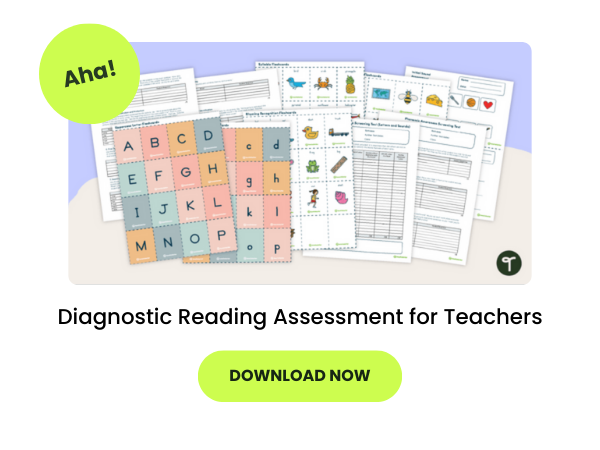Student assessment may be a crucial part of teaching, but let’s face it: With all the different types of assessment in education, it can be hard to keep track. There is assessment for learning, assessment as learning, and assessment of learning, and it seems every district has a different name for student progress monitoring that you need to learn.
So what are the basic types of assessment in education, and how do you integrate them into your pedagogy? We took a look at the various types of assessments that are done in early education to give you a starting point — or maybe just a refresher!
What follows is a list of the most common types of assessment that you’re likely to need as a teacher. This includes both low-stakes assessments — those that are not graded and have little meaningful consequence for students — and high-stakes assessments, which carry at least some consequence, such as a grade in your grade book.
Download a handy assessment data tracker for your student progress monitoring.
What Are the Types of Assessment in Education?
Diagnostic Assessment
A diagnostic assessment can be performed at the start of a school year to find out what your new batch of students knows — or doesn’t know — before you dive into the year. This pre-evaluation can also be performed at the start of a unit or an individual lesson to identify learning gaps and understand a student’s level of knowledge.
Diagnostic assessments should be low stakes, with any pre-testing used for a teacher’s knowledge rather than a grade, and they can be performed in an informal or more formal manner. For example, an informal assessment might involve student surveys or interviews, while a formal diagnostic assessment may involve a curriculum-based test.
This type of assessment is an important part of identifying students’ strengths that can be built upon, as well as weaknesses that need to be addressed as you move forward. Some other advantages of diagnostic assessment include:
- It provides a baseline for future assessment.
- It makes the learning process more efficient.
- It enables teachers to better individualize instruction.
- It allows teachers to tie learning outcomes to specific goals.
Formative Assessement
The formative assessment process takes place as you’re teaching a lesson. Because it’s been embedded in ongoing instruction, this type of assessment can help you change your teaching to meet students where they are at! You might want to think of this assessment type as a fly on the wall, listening in on what students are saying while you’re at the front of the room teaching.
Another low-stakes type of assessment, formative assessments are a valuable means for gauging student understanding as a lesson progresses. This type of assessment can be performed by something as simple as asking students to answer a few questions from a lesson on a sticky note or filling out an exit ticket. The goal is to use the assessment data to inform your decisions about how to proceed with your lesson, making adjustments for individual students or groups of students as needed.
Like the diagnostic assessment, this type of assessment in education is an important tool for teachers to spot learning gaps and adjust their pedagogy to address them.
Among the benefits of formative assessment, you’ll have:
- Immediate feedback on your teaching
- The ability to better individualize instruction (sound familiar?)
- The ability to provide targeted feedback
- Increased student participation
- A sense of achievement even for students who don’t fare well in a structured testing environment
- A window into what your students are thinking
Benchmark Assessment
Sometimes called interim assessments, a benchmark assessment can be performed periodically throughout the school year and evaluates students against specific standards or sets of standards.
Benchmark assessments provide teachers with baseline achievement data — akin to diagnostic testing — but they also measure student progress, evaluating students’ strengths and weaknesses along the learning path. A benchmark assessment typically falls after your formative assessment but before a summative assessment (more on that later).
Unlike formative assessments — which are substantially more informal — benchmarking is a formal fixed assessment. That means it involves asking all students the same questions or asking them to complete the same tasks. Benchmarking can be used along with the findings from the more informal formative assessments to help you monitor and evaluate instructional effectiveness.
The benefits of benchmark assessments include:
- Providing you with data to determine whether or not students are on track to meet goals
- Allowing you to make course corrections to meet the needs of individual students
- Providing you with data for parent/teacher communication
Summative Assessment
Unlike the types of assessment covered so far, there are often — but not always — high stakes associated with a summative assessment. Typically done “for a grade,” a summative assessment is performed at the summation or end of a period such as a semester, school year, or a unit.
Examples of summative assessments range from quizzes given at end of lessons, to projects or student portfolios, to district or state tests, but the goal is largely the same: To measure how much information a student has retained in relation to certain criteria. A summative assessment tells a teacher knowledge gained and skills acquired, but like other types of assessments, it can help you determine students’ strengths and weaknesses.
Among other benefits, summative assessments:
- Provide an understanding of what students have learned
- Let you know how prepared students are for the next period of learning (be it a lesson, unit of study, or even school year)
- Gives students a chance to implement their learning
- Identifies both teaching and learning gaps
Standardized Assessments
One particular type of summative assessment many students encounter in this day and age is the standardized assessment. This type of assessment collects test performance data from a cohort of students of a particular grade level and then compares students against a quantitative “norm” built using that performance data. State tests like the SOLs or PARCC are common examples of standardized assessments that use this method.
These norm-referenced assessments don’t evaluate students based on a set of standards, instead evaluating how they performed against that “norm.” Scores are then represented as percentiles, grade equivalents, or stanines.
These are often considered high-stakes assessments, but the direct effect on individual students varies. Some standardized tests may affect grade promotion, for example. Test scores from other standardized assessments may affect the teacher directly or the district as a whole.
Explore 5 teacher-tested ways to promote calm on state testing days.
Ipsative Assessments
An ipsative assessment is a type of assessment in education that is used to determine a student’s personal strengths, weaknesses, and growth.
Ipsative comes from the Latin ipse meaning ”of the self,” and in education, the term is typically defined as “comparing an individual’s performance on a measure to his or her past performances.” This type of assessment is a true measure of student progress. After all — it’s focused on the individual student! That’s significantly different from the standardized test, which compares students to a “norm.”
Ipsative assessments can be formed from other assessments. You may, for example, look at the pre-test given in the diagnostic assessment phase and compare it with results on a post-test given in the summative assessment phase for a truly quantitative assessment.
Get more help with your assessments with resources designed by our expert teacher team!
Banner image via Shutterstock/Monkey Business Images








Comments